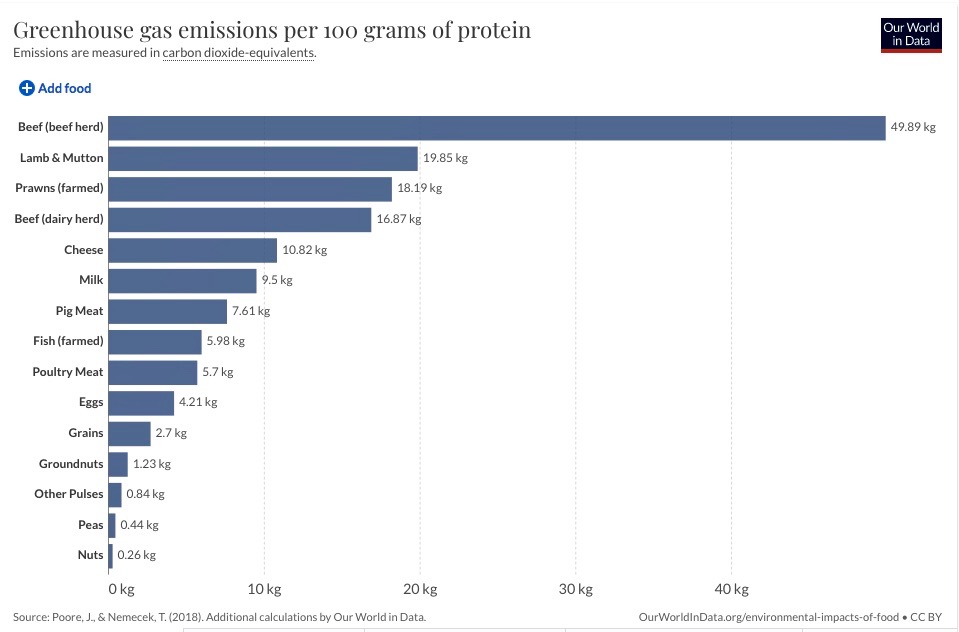Our Food and Climate Change
I thought it might be interesting this week to return to a very personal topic that we all encounter daily — food. What we eat, and don’t eat, impacts climate change. The diets of people around the world affect climate change.
More people in the U.S. are eating diets that include more plant-based foods. A recent survey found 63% making efforts to eat less red meat. Many are eating more plant-based foods because a plant-based diet is healthier–and the “best way to avoid heart disease.” Increasing numbers of people are turning to more plant-based foods to help the environment. A diet made up mostly of foods from plants is both healthier and better for the climate than the traditional family diet in the U.S.
Plant-based
What does this term “plant-based” mean? Eating a plant-based diet doesn’t mean you must be vegan or even completely vegetarian. A plant-based diet is one where most of the foods come from plant–such as vegetables, beans, nuts, and fruits–rather than from animals (ex. meat, poultry, and dairy). Such a diet can include modest amounts of fish, eggs, poultry, and dairy, and occasionally meat, as long as most of the food comes from plants.
Many people are eating more lentils, beans, quinoa, nuts, tofu, seitan, and tempeh–all good protein sources. Some are turning to meat alternatives such as the “Impossible Burger,” “Beyond Meat” products, and others. Sales of non-dairy milks made from almonds, soy, oats, and peas are increasing steadily.
What does this have to do with climate change?
Meat production causes greenhouse gas emissions in two major ways. The first is that ruminant animals, like beef cattle, produce methane, a greenhouse gas about 80 times more harmful than carbon dioxide, primarily through belching and farting. While it may be hard to believe, if cattle were their own nation, they would be the world’s third-largest emitter of greenhouse gases (behind China and the United States). The 60 billion land animals currently being raised for meat cause about one-fifth of all global greenhouse gas emissions, second only to fossil fuels.
Meat production also causes emissions by driving deforestation. The demand for meat around the world is growing, resulting in forests being cut down for grazing and for growing feed crops. This leads to emissions from clearing and burning forests and to a loss of the carbon sequestration provided by all those trees. Deforestation for cattle ranching has been a major cause of the destruction of the Amazon rainforest. (Raising meat currently uses almost 50% of all agricultural land in the world.)

The potential impact
The impact that could be achieved by large numbers of people shifting to plant-rich diets is so great that when the Drawdown Project calculated its effect it ranked in the top four out of the 100 solutions they identified as most effective in reducing emissions.
For most of us, changing our diet is not easy. But small changes can make a difference. Most people find it works best not to try to change their diet all at once. If you want to eat a more plant-based diet–whether for health or to preserve the climate–find a few plant-based foods that you already like and eat more of them, or try out something new from time to time. You can find some more details and suggestions in one of my earlier posts.
Food waste
The second big food issue related to climate is food that we don’t eat. Roughly one-third of all the food produced in the world is never eaten; it is wasted. Food waste is responsible for 8% of global greenhouse gas emissions–more than any country’s emissions, except for China and the U.S. The double tragedy is that this happens as more than 800 million (1 out of every 10) people in the world go hungry.
In low-income countries most food waste happens unintentionally before food gets to market, as a result of inadequate storage, lack of refrigeration, and transportation challenges. In the more wealthy countries food waste happens further along the supply chain and is more of a choice. As Drawdown says, “Retailers and consumers reject food based on bumps, bruises, and coloring, or simply order, buy, and serve too much. ” Too often at home people let food spoil, throw out leftovers, or reject it due to imperfections.
When food is wasted, we waste all the resources, energy, and water used to produce, package, and distribute it. Most wasted food ends up in landfills where it decomposes, emitting methane, that greenhouse gas with 80 times the global warming effect of carbon dioxide. Drawdown found that if humanity could make a 50% reduction in food waste, that the emissions saved would be so significant that this would also rank in their top four solutions to the climate crisis.
We can each make a difference now
Moving the public to eating more plant-based diets and wasting less food will require policies, innovation, education efforts, and addressing the food chain at every step along the way. Meanwhile, those of us who care about climate change, especially those of us in the wealthier countries, can make a difference individually now. Every time we choose to eat a plant-based meal and every time we avoid wasting food we reduce greenhouse gas emissions. We don’t need to be “perfect” in our food choices. Each small step we take makes a difference.
________________
The photo above is Atkins Reservoir in Shutesbury, MA, taken by Sara Barber-Just.
I’ll let you know when my next new post is available.
Click “Subscribe” below.

Good suggestions Russ. I feel that Daniel and I certainly eat less beef and are working on a more plant-based diet. It helps if you have your own garden and we do, always trying to expand for more vegetables. I volunteered in a community garden last summer and was pleased with the outcome and how much food we could distribute. No waste there!
Well done, Carol! All those things make a difference!
Wow, that line about if cattle were a country was shocking!!!
Small choices every day can make a difference? I’m in!
Adopting the cuisine of cultures that use less meat helps. It’s easier to change if stuff tastes good. For example, Indian food. There is so much information online that makes it easier to eat a vegan diet. For example, my wife is able to make vegan baked goods that taste good. Who knew! It used to be just oat cakes with rutabaga sauce. Now we have stuff like pumpkin scones, jam bars, Irish soda bread, etc.
It would be interesting to see the difference in climate impact between Nebraska feed lot beef and grass fed beef grown in the Pioneer Valley. Another option is deer meat. Without predators, deer are wiping out native species. We could use fewer deer, but no one (including me) wants to go hunting.
Thanks, Jack. I agree. I’ve found vegetarian Indian food a joy to cook and to eat. It has become a major replacement for meat in my diet.
Some people do hunt deer specifically for the meat. I’m not interested in hunting myself, but I respect that for some families it’s a way to help with limited budgets.